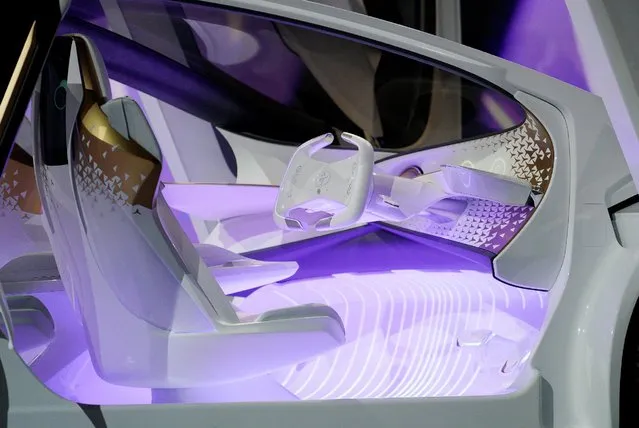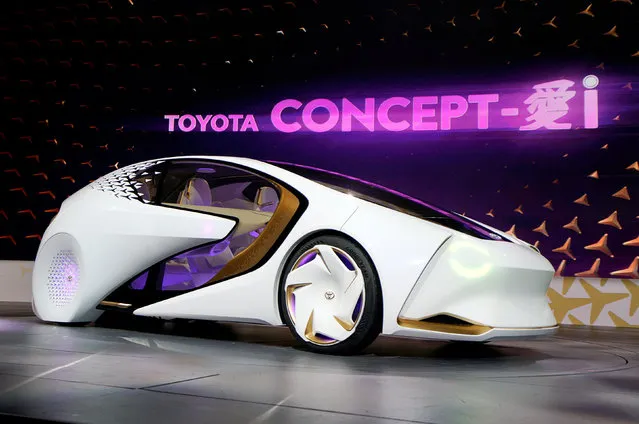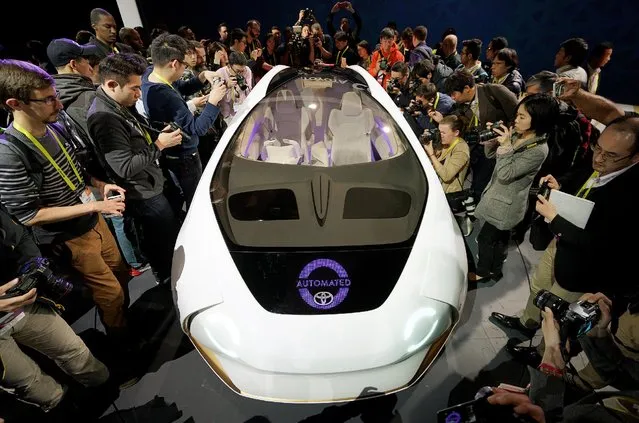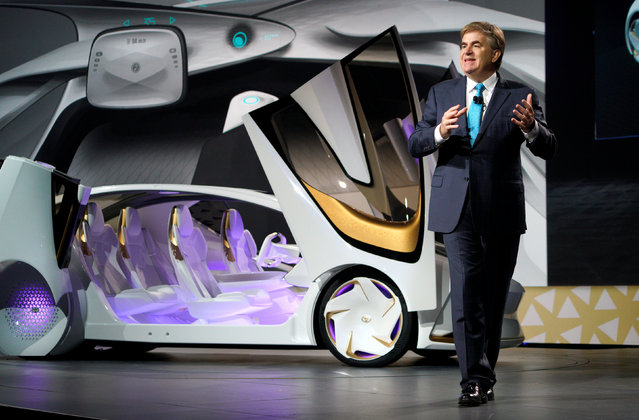
The new Toyota Concept-i concept car, designed to learn about its driver is seen just before being unveiled during the Toyota press conference at CES in Las Vegas, January 4, 2017. Concept-i is a compact autonomous car with a swoopy and organic design. However, the most interesting – and difficult to explain – bit is the interior. The cabin is pretty much devoid of traditional black touchscreen displays. This is part of what Toyota's California-based CALTY Design Research crew and the Toyota Innovation Hub call the philosophy of “kinetic warmth – a belief that mobility technology should be warm, welcoming, and above all, fun”. Basically, Toyota thinks that we should have a more human and immersive relationship with our vehicles. So, instead of buttons and screens passengers interact with the vehicle's artificial intelligence (AI) agent, nicknamed “Yui”, which will anticipate the onboard humans' needs, measure their emotions and responds automatically. These responses could be verbal (like suggesting a destination) or through mood enhancing environmental cues (such as altering the lighting throughout the cabin). Passengers can also just talk to Yui like they would Siri on their smartphone to make natural language requests. Designed for both autonomous and piloted driving, Concept-i features a steering wheel and driver aid features like projecting video views onto the rear pillars to eliminate blind spots and a next-generation head-up display that helps keep the driver's eyes and attention on the road. This touchy-feely relationship with technology continues outside of the cabin, which allows Yui to greet the approaching driver through exterior displays and an opening of the vertically hinged doors. The exterior also features dynamic graphics that inform pedestrians whether the Concept-i is its in autonomous or human-piloted modes and can share visual information about the road ahead through graphics on the vehicle's rear. (Photo by Rick Wilking/Reuters)

The new Toyota Concept-i concept car, designed to learn about its driver is unveiled during the Toyota press conference at CES in Las Vegas, January 4, 2017. (Photo by Rick Wilking/Reuters)

The new Toyota Concept-i concept car, designed to learn about its driver is unveiled during the Toyota press conference at CES in Las Vegas, January 4, 2017. (Photo by Rick Wilking/Reuters)

The new Toyota Concept-i concept car, designed to learn about its driver is unveiled during the Toyota press conference at CES in Las Vegas, January 4, 2017. (Photo by Rick Wilking/Reuters)

The new Toyota Concept-i concept car, designed to learn about its driver is unveiled during the Toyota press conference at CES in Las Vegas, January 4, 2017. (Photo by Rick Wilking/Reuters)

The new Toyota Concept-i concept car, designed to learn about its driver is unveiled during the Toyota press conference at CES in Las Vegas, January 4, 2017. (Photo by Rick Wilking/Reuters)

The new Toyota Concept-i concept car, designed to learn about its driver is unveiled during the Toyota press conference at CES in Las Vegas, January 4, 2017. (Photo by Rick Wilking/Reuters)

The new Toyota Concept-i concept car, designed to learn about its driver is unveiled during the Toyota press conference at CES in Las Vegas, January 4, 2017. (Photo by Rick Wilking/Reuters)

Bob Carter, Senior Vice President of automotive operations at Toyota, unveils the new Toyota Concept-i concept car, designed to learn about its driver, during the Toyota press conference at CES in Las Vegas, January 4, 2017. (Photo by Rick Wilking/Reuters)

The new Toyota Concept-i concept car, designed to learn about its driver is unveiled during the Toyota press conference at CES in Las Vegas, January 4, 2017. (Photo by Rick Wilking/Reuters)
05 Jan 2017 13:20:00,
post received
0 comments
